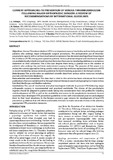| dc.contributor.author | Imbaya, CL | |
| dc.contributor.author | Gakuu, LN | |
| dc.contributor.author | Ng’ang’a, Z. | |
| dc.contributor.author | Kombe, Y | |
| dc.date.accessioned | 2014-06-22T09:26:19Z | |
| dc.date.available | 2014-06-22T09:26:19Z | |
| dc.date.issued | 2014 | |
| dc.identifier.citation | East African Orthopaedic Journal Vol 8, No 1 (2014) | en_US |
| dc.identifier.uri | http://www.ajol.info/index.php/eaoj/article/view/104544/94612 | |
| dc.identifier.uri | http://hdl.handle.net/11295/70384 | |
| dc.description.abstract | Objectives: Venous Thromboembolism (VTE) is an important cause of morbidity and mortality amongst
patients who undergo major orthopaedic surgical procedures. The perioperative use of thromboprophylactic
agents with or without mechanical compression has demonstrated significant lowering of
the incidence of VTE among post-operative patients. Various pharmacological and mechanical agents
are available locally in both oral and injection forms but there are no standard guidelines or a consensus
statement on their utilization. This is the case despite there being a gradual rise in the number of
patients who undergo hip and knee replacement surgery in Kenya. The purpose of this paper is to
review the current approaches being used to reduce post hip and knee replacement incidences of VTE
as recommended by various external guidelines for benchmarking purposes in the Kenyan context.
Data Sources: This article relies on published scientific data from various online resources including
journals and electronic databases.
Data selection and extraction: The data that is cited in this article has been referenced from health
publications that are available online through internet literature search and googling Cochrane review,
Pub Med, MedScape and Medline websites.
Conclusions: The use of mechanical and pharmacological methods to prevent VTE following major
orthopaedic surgery is recommended and practiced worldwide. The choice of the prophylactic
regimes should be adapted to patient needs taking into consideration their risk profiles for bleeding
and development of VTE as well as the availability and access to the prophylactic treatment. Several
countries have developed VTE prevention guidelines in line with international practice and adapted
them to their local situations. In the Kenyan context a gap remains for development of local VTE
prevention guidelines that will inform and enable clinicians to make rationale choices while selecting
appropriate VTE prevention measures. | en_US |
| dc.language.iso | en | en_US |
| dc.title | Current approaches to prevention of venous thromboembolism following major orthopaedic surgery: a review of recommendations by international guidelines | en_US |
| dc.type | Article | en_US |

